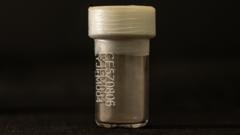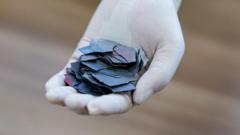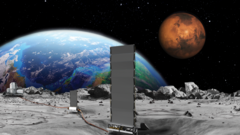The recent arrival of Moon dust in the UK marks a significant milestone in scientific exploration, as 60 milligrams from China's Chang'e 5 mission in 2020 are now entrusted to Professor Mahesh Anand's team in Milton Keynes. This unique material, considered "more precious than gold dust," allows researchers to explore the Moon's formation and early Earth history. The mission underscores a new era of international collaboration in space science as experts aim to unlock cosmic secrets from these rare samples.
**Historic Moon Dust Samples Arrive in the UK: More Precious Than Gold**

**Historic Moon Dust Samples Arrive in the UK: More Precious Than Gold**
The world’s first lunar dust, brought back by China, lands safely in the UK for groundbreaking research.
The first lunar samples collected in decades have touched down in the UK from China, marking an exciting chapter in planetary science. These grains, locked away in a secure facility in Milton Keynes, come from China's successful Chang'e 5 mission, which returned 2 kg of Moon rock in late 2020. Professor Mahesh Anand, the sole UK scientist given access to these samples, describes the Moon dust as "more precious than gold dust," offering unprecedented opportunities to unravel cosmic mysteries.
Brought back from Mons Rümker, a volcanic region on the Moon, these samples are essential for examining hypotheses regarding the Moon's origins, particularly the theory that it formed from debris resulting from an impact with a Mars-sized body 4.5 billion years ago. The Moon dust was collected by a robotic arm during China’s space mission, which was the first of its kind since the Soviet Union's efforts in 1976.
At a recent ceremony in Beijing, Professor Anand received the samples with colleagues from Russia, Japan, and Europe, symbolizing a growing international partnership in space exploration. He returned to the UK with the samples in his hand luggage, ensuring their safety during transit.
In his lab, strict protocols are in place to prevent contamination, including special clothing and cleanroom foot coverings. The Moon dust is encased in secure vials, creating a controlled environment for the analysis. With only a small amount available, researchers like technician Kay Knight are eager yet cautious, understanding the stakes of working with such rare materials.
Professor Anand’s laboratory has been equipped with advanced technology capable of heating the dust and analyzing its elemental composition. Through this research, they aim to extract vital data about the Moon's geological history. Though their investigations may result in the destruction of the samples, Professor Anand advocates for further international collaboration, hoping that this project heralds a new era of cooperation in lunar and planetary studies.
China continues to expand its role in lunar exploration, with plans for the Chang'e 6 mission in 2024, set to collect samples from the Moon's uncharted far side. Such advancements enhance the potential for global scientific partnerships, making the exploration of our cosmic neighbor all the more intriguing.


















